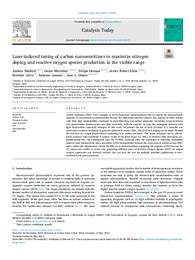Por favor, use este identificador para citar o enlazar este ítem:
https://hdl.handle.net/11000/35637Registro completo de metadatos
| Campo DC | Valor | Lengua/Idioma |
|---|---|---|
| dc.contributor.author | Madrid, Ainhoa | - |
| dc.contributor.author | Martinez, Gema | - |
| dc.contributor.author | Hornos, Felipe | - |
| dc.contributor.author | Bonet Aletá, Javier | - |
| dc.contributor.author | Calvo, Estevan | - |
| dc.contributor.author | Lozano, Antonio | - |
| dc.contributor.author | Hueso, José L. | - |
| dc.contributor.other | Departamentos de la UMH::Agroquímica y Medio Ambiente | es_ES |
| dc.date.accessioned | 2025-02-14T08:05:05Z | - |
| dc.date.available | 2025-02-14T08:05:05Z | - |
| dc.date.created | 2023-10-01 | - |
| dc.identifier.citation | Catalysis Today, Volume 422, 1 October 2023, 114214 | es_ES |
| dc.identifier.issn | 1873-4308 | - |
| dc.identifier.issn | 0920-5861 | - |
| dc.identifier.uri | https://hdl.handle.net/11000/35637 | - |
| dc.description.abstract | Carbon nanodots (CNDs) have emerged as novel fluorescent nanosensitizers able to expand the photocatalytic response of conventional semiconductors beyond the ultraviolet spectral window. Key aspects of CNDs related with their high photostability, resistance to photobleaching and optical properties (including downconversion and upconversion luminescence) are often associated with the capacity to dope the carbogenic network with light heteroatoms, especially nitrogen. In this work, we present the use of laser pyrolysis as a versatile and convenient synthesis technique to generate different N-doped CNDs. The level of N doping can be tuned through the selection of a single liquid solvent containing N as carbon precursor. This liquid precursor can be alternatively enriched with additional N sources co-fed in the form of gas (i.e. NH3) or disolved solid precursors (i.e. phtalocyanine-Ph). We demonstrate that the N-CNDs retrieved after the additional N cofeeding treatments improve their photoactivity when assembled to P25 nanoparticles towards the conversion of methyl orange (MO) under white LED illumination. All the N-CNDs act as photosensitizers expanding the response of P25 beyond the UV region and exhibit an active role generating different types of Reactive Oxygen Species (ROS) via singlet oxygen, superoxide and hydroxyl radicals that can pave the way for multiple potential applications in environmental and green processes. | es_ES |
| dc.format | application/pdf | es_ES |
| dc.format.extent | 9 | es_ES |
| dc.language.iso | eng | es_ES |
| dc.publisher | Elsevier | es_ES |
| dc.rights | info:eu-repo/semantics/openAccess | es_ES |
| dc.rights | Attribution-NonCommercial-NoDerivatives 4.0 Internacional | * |
| dc.rights.uri | http://creativecommons.org/licenses/by-nc-nd/4.0/ | * |
| dc.subject | Carbon Dots | es_ES |
| dc.subject | Nitrogen doping | es_ES |
| dc.subject | Laser Pyrolysis | es_ES |
| dc.subject | P25 | es_ES |
| dc.subject | Photocatalysis | es_ES |
| dc.subject | ROS | es_ES |
| dc.subject.other | CDU::5 - Ciencias puras y naturales | es_ES |
| dc.title | Laser-induced tuning of carbon nanosensitizers to maximize nitrogen doping and reactive oxygen species production in the visible range | es_ES |
| dc.type | info:eu-repo/semantics/article | es_ES |
| dc.relation.publisherversion | https://doi.org/10.1016/j.cattod.2023.114214 | es_ES |

Ver/Abrir:
2 - 1-s2.0-S0920586123002389-main.pdf
7,04 MB
Adobe PDF
Compartir:
 La licencia se describe como: Atribución-NonComercial-NoDerivada 4.0 Internacional.
La licencia se describe como: Atribución-NonComercial-NoDerivada 4.0 Internacional.
.png)